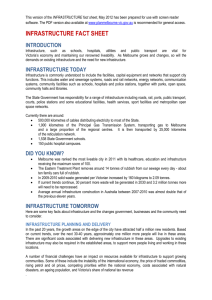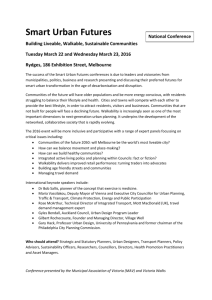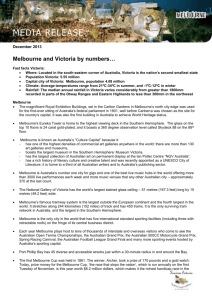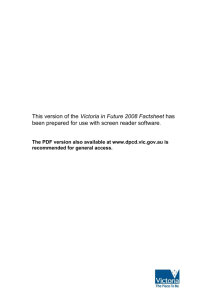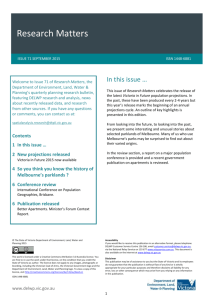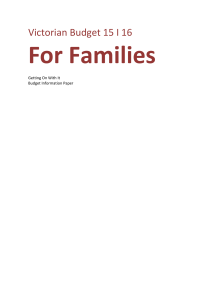Environment Fact Sheet (DOC - 19KB)
advertisement
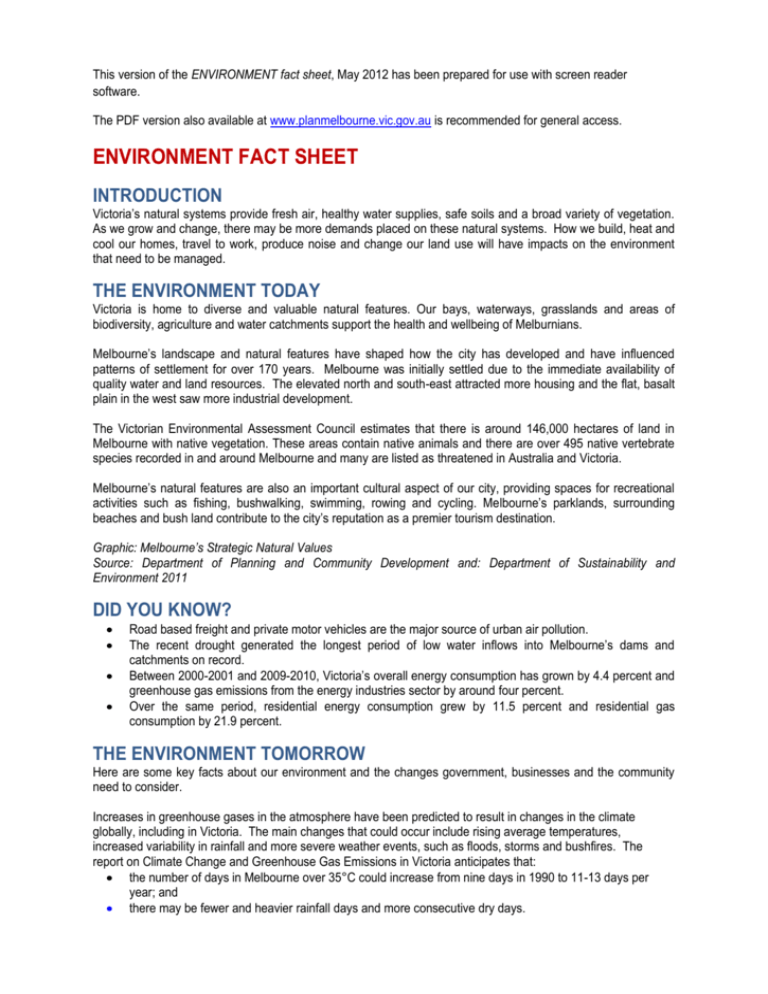
This version of the ENVIRONMENT fact sheet, May 2012 has been prepared for use with screen reader software. The PDF version also available at www.planmelbourne.vic.gov.au is recommended for general access. ENVIRONMENT FACT SHEET INTRODUCTION Victoria’s natural systems provide fresh air, healthy water supplies, safe soils and a broad variety of vegetation. As we grow and change, there may be more demands placed on these natural systems. How we build, heat and cool our homes, travel to work, produce noise and change our land use will have impacts on the environment that need to be managed. THE ENVIRONMENT TODAY Victoria is home to diverse and valuable natural features. Our bays, waterways, grasslands and areas of biodiversity, agriculture and water catchments support the health and wellbeing of Melburnians. Melbourne’s landscape and natural features have shaped how the city has developed and have influenced patterns of settlement for over 170 years. Melbourne was initially settled due to the immediate availability of quality water and land resources. The elevated north and south-east attracted more housing and the flat, basalt plain in the west saw more industrial development. The Victorian Environmental Assessment Council estimates that there is around 146,000 hectares of land in Melbourne with native vegetation. These areas contain native animals and there are over 495 native vertebrate species recorded in and around Melbourne and many are listed as threatened in Australia and Victoria. Melbourne’s natural features are also an important cultural aspect of our city, providing spaces for recreational activities such as fishing, bushwalking, swimming, rowing and cycling. Melbourne’s parklands, surrounding beaches and bush land contribute to the city’s reputation as a premier tourism destination. Graphic: Melbourne’s Strategic Natural Values Source: Department of Planning and Community Development and: Department of Sustainability and Environment 2011 DID YOU KNOW? Road based freight and private motor vehicles are the major source of urban air pollution. The recent drought generated the longest period of low water inflows into Melbourne’s dams and catchments on record. Between 2000-2001 and 2009-2010, Victoria’s overall energy consumption has grown by 4.4 percent and greenhouse gas emissions from the energy industries sector by around four percent. Over the same period, residential energy consumption grew by 11.5 percent and residential gas consumption by 21.9 percent. THE ENVIRONMENT TOMORROW Here are some key facts about our environment and the changes government, businesses and the community need to consider. Increases in greenhouse gases in the atmosphere have been predicted to result in changes in the climate globally, including in Victoria. The main changes that could occur include rising average temperatures, increased variability in rainfall and more severe weather events, such as floods, storms and bushfires. The report on Climate Change and Greenhouse Gas Emissions in Victoria anticipates that: the number of days in Melbourne over 35°C could increase from nine days in 1990 to 11-13 days per year; and there may be fewer and heavier rainfall days and more consecutive dry days. Victoria has a naturally variable climate and already experiences severe weather events, such as bushfires, floods and hail storms. Recovering from these events comes at a cost to the community, business, individuals and government. Planning for the future will require consideration of how to manage these changes and the impacts they have on communities. TEMPERATURES Victoria is experiencing higher average annual temperatures. Since 1910, the Victorian average annual mean temperature has increased by about 0.8°C. The greatest increase in average and maximum temperatures has occurred in spring while minimum temperatures increased the most in summer. RAINFALL Between 1997-2009, Victoria experienced its driest period on record, with total annual rainfall decreasing by 13 percent. In contrast, frequent heavy rain events during 2010-2011 resulted in above average rainfall conditions across Victoria. January 2011 was the wettest January in Victoria’s records. Even with the recent wet weather, total rainfall over the past 15 years remains below average across most of Victoria, including Melbourne. SEVERE WEATHER EVENTS The Bureau of Meteorology reported that the two hailstone storms in March 2010 resulted in losses estimated to exceed $1 billion. The storms lasted less than 30 minutes and flash flooding and hail caused widespread damage to cars and homes. ENERGY The Australian Energy Market Operator reported that for Victoria over the next 10 years: electricity demand is expected to grow by an average of 1.6 percent every year maximum peak demand such as on a hot summer afternoon, is expected to grow by an average of 2.2 percent per year. HAVE YOUR SAY We are seeking your thoughts and ideas on Melbourne’s future. Join our online forums to discuss: What do you think the priority should be when planning for a sustainable Melbourne that can adapt to more extreme weather events and changes in the climate? Graphic icons showing links to social media and communication tools – Twitter is #planmelbourne Internet website is www.planmelbourne.vic.gov.au Email to planmelbourne@dpcd.vic.gov.au Subscribe to the newsletter



